The incompatibility matrix
This week: Painting; Future proofing; A hole in the wall; The incompatibility matrix; Some sadness; Garden matters;
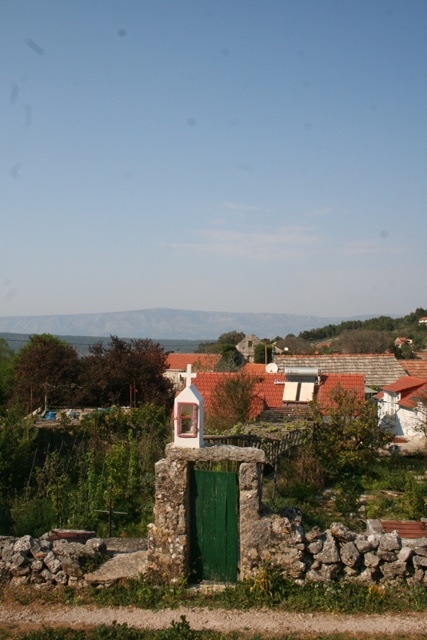
I listen to the wireless a lot. For one thing, you can have the wireless on and do other work at the same time.
If you have the TV on, you need to sit and watch it. Just listening to the TV is not the same. Programmes made for radio are produced with the absolute understanding that they have to convey visual meaning, but just using words and sounds.
What I have noticed especially this week, is how much content there now is about COVID-19, the international lockdown, how it is affecting people. A lot of the non news programmes are about transporting the listeners to somewhere other than their particular premises of home isolation.
For me the lockdown is an inconvenience not a disaster. I can’t just ‘pop into town’ to buy something I need. I either do without, use something else, or as a last resort, order on line.
What I now understand is that I had already unknowingly chosen a degree of self isolation, and I am comfortable with this lifestyle. This is not something that most readers will have chosen.
I’m extremely lucky because like farmers, I have a lot of space where I can go wandering, without fear of meeting anyone. Let alone someone who might have the virus. I can wave to neighbours and talk, observing social distancing of course. But we no longer meet up for coffee.
True there are many jobs to do, but it is actually my work, even if it takes place in nice surroundings, in good weather and generally untroubled by ravages of the pandemic.
I’m carrying on in a mostly unaltered way, but taking sensible precautions. When I hear of the people in the high rise apartments, with no access to any green space, or only a corridor to take exercise in, I recognise the fortunate position I am in.
Where ever you are physically located when you read this, what ever your situation, it will come to an end. In the meantime please stay safe…
Painting
When the daytime temperature is +25ºC and the humidity is low, it is amazing what you can achieve in a day.
I want my new building work to be sympathetic to the surroundings. Using local stone and natural materials where ever possible, whilst at the same time making the best use of modern techniques, like double glazing and thick wall insulation.
My design for the original courtyard is as a trafditional Mediterranean living space. OK, at the moment you wouldn’t think so, what with the wonky old walls and just sand and stones under foot.
But my plan is very clear. There will be nice stone sets to walk on, with a fair wind perhaps even before the end of this summer.
The doorways are all traditional stone, including the newly constructed entrance to the workshop. So too the windows and doors that look onto the courtyard are all wooden framed.
Wood does of course mean maintenance. The factory made window and access door into the electrical plant room came as “bare wood”. All the frames have had a coat of primer and undercoat before they were fitted into the voids in the wall.
Having fitted the frames, I gave them a coat of white gloss enamel as the finish this week.
Then I set about the wooden windows and doors.
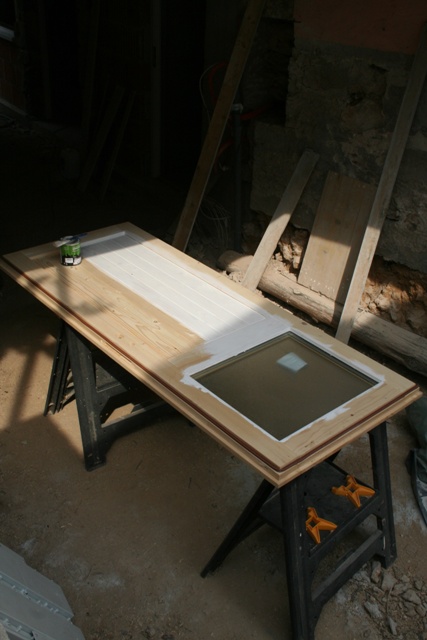
At the end of the week, all the bought in wood fittings are ready for their final coat of gloss enamel, having had the primer and undercoat. They have been rubbed down with a 200 grade sandpaper between coats as well.
Future proofing
Cvjetko arrived on Wednesday with the insulation. Every country is different when it comes to building regulations and hence the techniques and materials used.
I am used to the UK systems.
Good insulation is a requirement in any new build, but it can be achieved in a number of ways. Most walls are built with a cavity between the inner and outer surfaces.
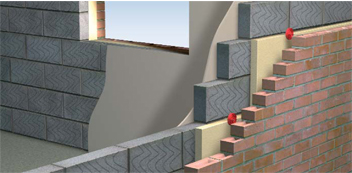
This is filled with an insulating material, but you can also get “thermalite” blocks, made of a material with an already high thermal retention value, or concrete blocks with a central core of Styrofoam.
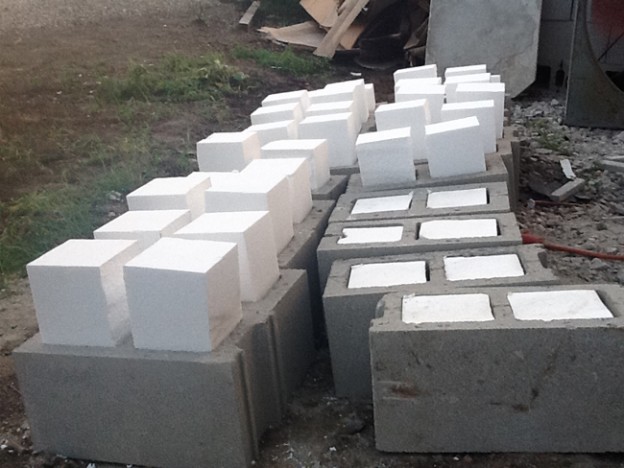
Not so here. Walls in the old days were solid affairs.
Built up to a metre thick, made of local stone with the gap between the inner and outer faces filled with small stones, sand and lime mortar.
Here even modern walls are still solid, either made of concrete blocks or of red clay honeycomb “Ziegel” blocks. The clay is the best and most expensive walling.

The clay blocks come in different sizes from 7 cm to 25 cm in width. All have holes in them, with the 25 cm type having 13 in 6 parallel rows.

The architect enquired about thermalite blocks, but they are not available. Instead we are sticking 80 mm thick sheets of Styrofoam to the outside of the clay blocks.
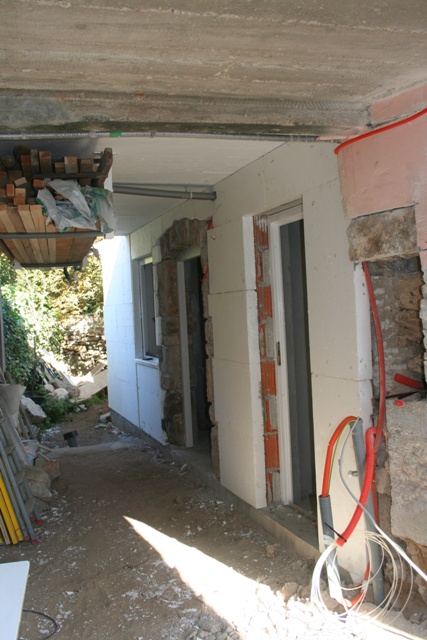
Everything I do is about the future and I recognise that while I want the new building to be a workshop, in the future it may need to be repurposed. So I might as well make it warm now, hence it is double glazed and is built of thermally efficient materials.
By the end of the week most of the insulation has been applied.
A hole in the wall
Future proofing also requires a degree of imagination as well as planning.
I want to make sure that everything possible is put into the walls now, so that there will be no need for the foreseeable future, to dig holes and make unsightly changes.
At some point (hopefully soon) the roof will be replaced on my main building. I would then like to have PV panels to generate electricity. However when the time comes, I don’t want to run wires along and down the outside of the building.
As I have rewired my home, changing the ancient and unsafe wiring to modern standards, all the cables have been routed in conduit. Running this between buildings has been a challenge.

These are the cables for the kitchen, cooker, lighting, ring main and also thin Ethernet internet cables, even UHF antenna cable for my weather station. Each has been encased in a plastic pipe as extra protection.
They look unsightly, but this is where the entrance to the lounge will be, and everything will be hidden in walls or concrete.
However I need to get the cabling down into the electrical plant room, next to the workshop, without having to dig holes in the walls.
This week I cut a hole in the old building’s wall, to take a large bore plastic pipe, which will be the means of getting all the wiring into the plant room.
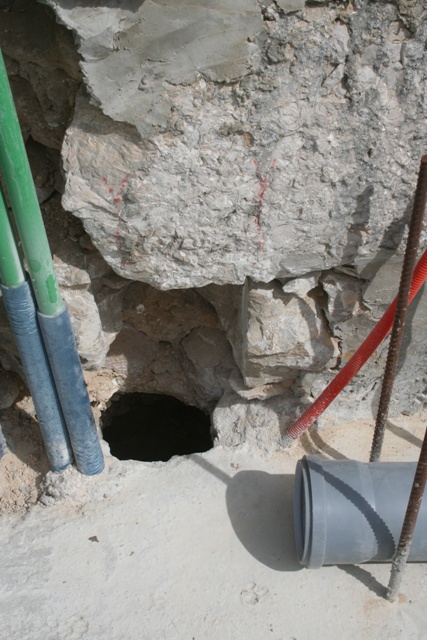
It took a bit of time, quite a few different tools and I made a lot of dust, but the job is now done.
The pipe will soon be concreted into place and can then easily be extended upwards as necessary to take all the various wiring, direct into the electrical plant room.
Once the wall is plastered, you will never know it is even there.
The incompatibility matrix
I’ve been doing some wiring this week. Some of it has been to keep ahead of Cvjetko, or more accurately, not to hold him up. But some has also been to get on with the completion of the workshop.
With work going on to insulate the outside of the building, I needed to make sure that cable conduit for outside lights and switches was buried behind the sheets of insulation.
All the wiring has been meticulously planned so that it is out of sight.
Whether that means being buried in the floor or the ceiling, or behind the render, I do not want any wires to be left showing, anywhere.
There will be some nice wall lights in the courtyard, but these require a power feed, a pair of switches and the various cables to be joined.
Although it doesn’t look much, there is a full morning’s work involved in installing the circular junction box and then making all the various connections.
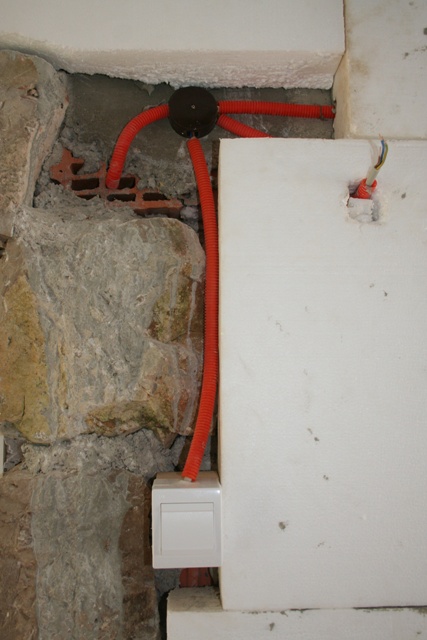
The wall had to be drilled and plugged to take the junction and the light switch, then the wiring run out and held in place. But the finished work is neat and will be completely hidden.
You would think that electrical fixtures and fittings would be common across the whole of the EU. Not so I’m afraid.
Whilst the majority of countries, including Croatia, use the Schuko Type F plugs, the actual wall sockets are made by a number of different European manufacturers.
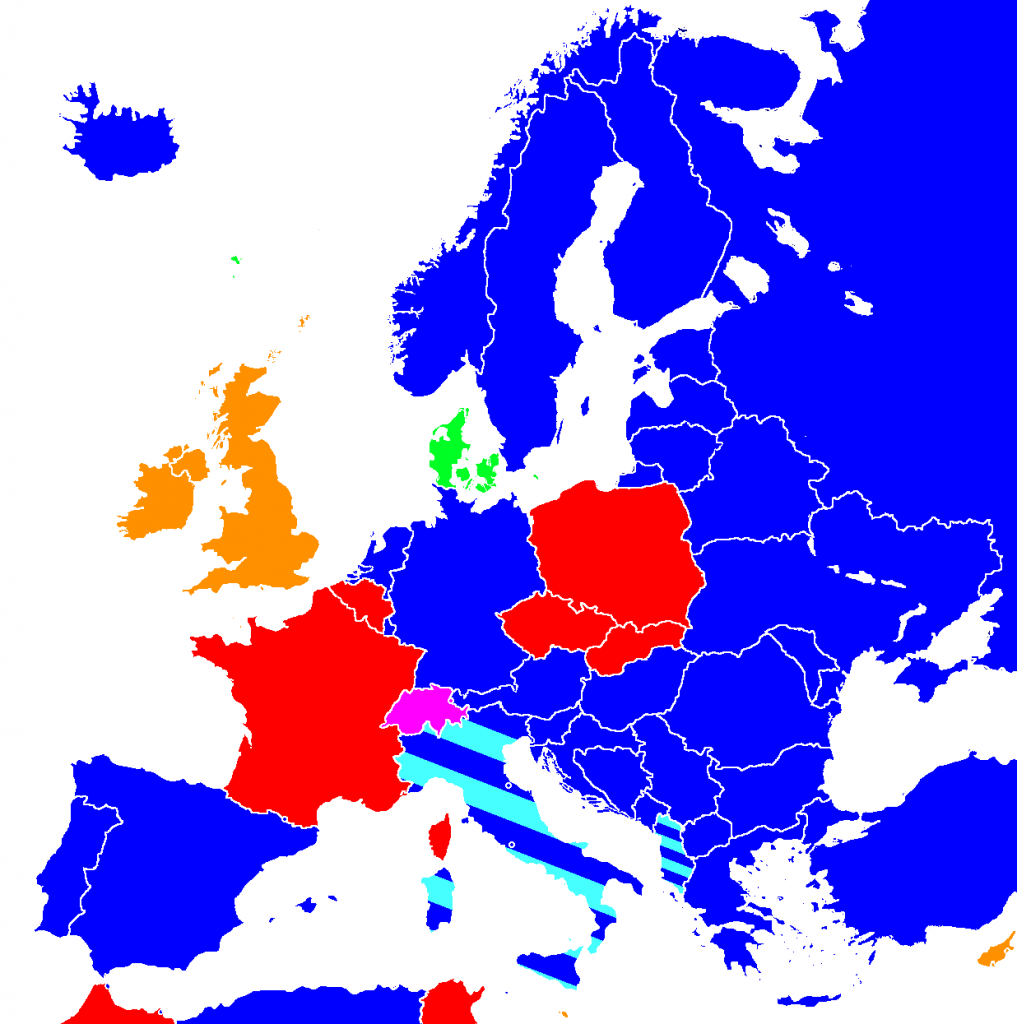

I have a large supply of parts so I thought I would get ready for putting the electrics into the workshop.
The system is made up of four parts. There is a plastic box which goes into a recess in the wall, called a pattress box. Then there is a mounting plate which is screwed into the pattress box.
Various combinations of units can be mounted into the plate, Schuko sockets, switches, antenna cable connectors etc., and finally there is the face plate which clips over the front so everything looks neat.
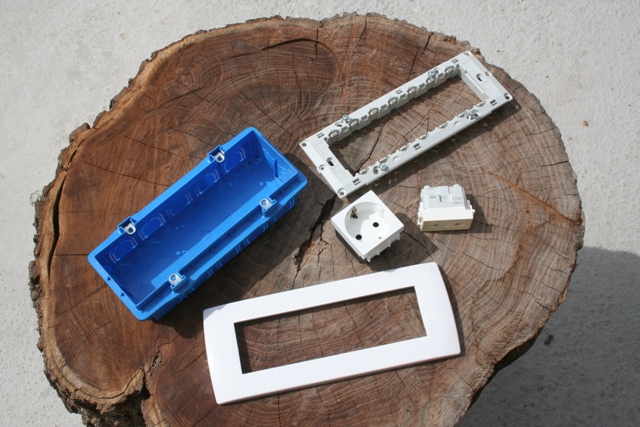
I have standardised on a particular make of pattress box. They come in different sizes so you can fit a single switch, or multiple plugs, as you choose. You then need to have the correct size mounting plate for the pattress box.
This is where it starts to get difficult because some mounting plates are only made to fit the manufacturers propitiatory pattress box.
The individual elements that go into the mounting plate also will only fit certain plates. And finally the face plate must be the same brand as the mounting plate.
I discovered that in my supplies box, I had three different makes of mounting plate, the same three different makes of fittings, but only two makes of face plate.
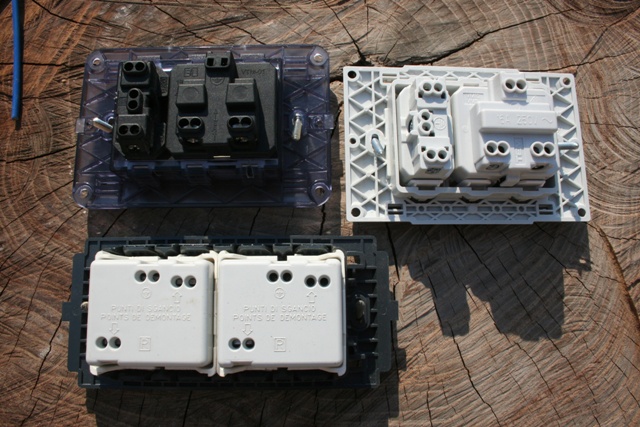
All these have been bought in Split and are not available on the island. The difference in fittings is only small, but it is enough so that everything is mutually incompatible.
I have created a matrix of what fits, together with a list of my stock. This is so I know what I need to buy when we are allowed to travel to the mainland again.
So much for the great European push for standardisation. While the Schuko plugs might be standard and they will fit all the makes of fittings in a plate, that is where commonality ends.
There is no possibility of going to the mainland until after the COVID-19 epidemic has ended, so I was only able to finally wire up a a couple of the new sockets in the workshop. The rest will have to wait until I can do a re-supply run to the mainland.

Some sadness
I seem to have gained another feline this week.
Gizmo, now being around 9 months old, is turning into an adolescent. This week he brought a girlfriend home.
She is about the same age, mostly white with a black face and tail and turns up for food when ever Gizmo arrives.

She has a nice temperament and is clearly habituated to humans. They play together which is nice because my two old cats get annoyed when Gizmo jumps out and tries to play chase.
However he is a hunter. At the moment the fairly slow moving Egyptian Grasshoppers are things to be caught and brought home for a little bit of play.
Generally I can retrieve them, perhaps minus a leg. But they are still able to fly, so I deposit them somewhere out of his sight.
On Saturday morning, I found him playing with his latest trophy. I thought at first it was a small mouse until I got up close.

Sadly be has brought home a Pygmy Shrew, Sorex minutus.
The dictionary of Mediterranean wildlife says that shrews in general are absent from most islands.
Although I have never seen these tiny mammals, I knew that there were some around my home. This is because Callie brought me some live examples a couple of years back.
They were released back into the garden. There was nothing I could do for this little chap.
As Gizmo loves to play with boot laces, I am just waiting for him to turn up with his first snake!
You can’t change the nature of felines unfortunately. There is even a theory that a well fed cat is a better hunter. This is because they have more patience, not needing to devour the first thing they catch.
Garden matters
Although I am irrigating at the moment, many of my plants sem still to be able to find some moisture. I have my English Bluebells in flower at the moment.

Not quite a carpet, but they are gradually increasing in number.
I was delighted this week to find that my garden orchids, Calanthe, are in flower.

Even with a strong perfume, the diminutive magenta flowers are easy to miss.
A much more showy flower is that of the Salsify, Tragopogon porrifolius,

They open around nine for just three hours and by lunch time the flower has closed. Each plant only has a single stem and flower. They are wild flowers and readily self seed.
Also in flower this week is my Lilac, Syringa vulgaris, here with a Green Rose Chafer, Cetonia aurata feeding on the nectar.

The Lilac is a Balkan native and part of the Olive tree family. It is used now in gardens across Europe and North America to provide spring colour.
The scent from the mauve flowers is quite delicate and it remains green until very late in the year.
I have still not been able to identify my Hippeastrum variety. However it has produced another stem with five large flowers. The first flowers have set seed.

The first crop of figs are steadily growing. It looks like a bumper crop this year too, however then I need to prune the tree back.

I can always find things to do. The problem at the moment is that there are just too many! NRC
3 Responses
Lynn Woolsey
When I read about a bit of sadness I had to jump to that section. I was happily relieved that the victim was a shrew rather than a beloved feline!
All is well here. Safe and with some space to walk around. Take care!
Elizabeth
Same here, as Lynn, I was worried about your puss cats – particularly the oldies. Pleased it wasn’t one of them but sorry that you had to be treated to a shrew. At least you know that they are around.
In my experience, getting cats through to two years is the critical time – they are more likely to dice with cars and other dangers – as they get older they become more sensible… maybe?! My cats seemed to stop really hunting after about two or three – I would say being well fed makes them lazy! So keep feeding 😀
Like you, we are pretty happy being insular – just miss being able to do and go, where and when we like. Meanwhile, work continues and we are thankful for the technology that allows that, and communication, to be so easy.
Here I have noticed that people, on social media, are starting to say thank you to all the low paid and under-valued people who make our more affluent lives possible… maybe they will become valued enough to be able to attract a proper wage? One hopes so and we will all need to accept that things might have to cost a bit more and budget accordingly. Though, sadly, it has been ever thus. Time for a change?
Meanwhile, stay safe and keep sending your blog posts. Best wishes…
Andrew Robinson
I was always told that a cat would eat a mouse, but not a shrew. We had lots of cats on the farm, and they often caught mice and rats which they ate except for the tail…. But we would often find whole shrews, killed but not eaten. Maybe they taste bad!